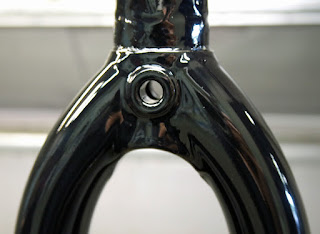After the frenzied pre-Christmas preparations, the corridor linking Christmas and New Year can be perfect for catching up with friends and small jobs. Aside from ignition tumbler woes striking my KA, my fixed gear winter/trainer's seat post binder bolt needed replacing.
Since it was secure and I didn't need to adjust the post height, I left it a couple of months. All the same, I wanted to avoid the expensive, titanium post/Cro-moly frame galvanic union. One last try, with Torx bits confirmed drilling-out was the only option.
Cordless drill charged, and bits found...
I also harvested a compatible replacement bolt and collar, in case the 14 year old On-One also decided to give up the ghost. Knew they'd come in handy... Bike in the workstand, It took a few minutes cautious drilling before the once 5mm Allen head disintegrated. Thankfully the threaded section also required little coaxing.
Much as I suspected, the On-One collar had succumbed to fatigue, so that was substituted for an Atomic22. Though not unexpected, it was still a relief to discover the post was also very mobile. I eased that free, removed the remaining greasy film and introduced a liberal helping of ceramic prep.
While harvesting bolts, I also discovered two packet fresh 26x1.75 inner tubes. Timely, since my Univega's supplies were dwindling and I'd patched a few to their limit recently. I took this opportunity to carve another section from a dead 26x2.0 and make a seat collar boot for my fixed.
Post reinstated, fasteners greased and snugged tight, I slid the boot so it obscured the frame's collar slot.
In some respects I could've cut it longer, overlapping the post for optimal protection.
However, this would've been as pain, should I need to re-tighten the collar bolt mid-ride. I also replaced the VDO computer head unit's battery.Mercifully, it has a memory function, which saves time and minor hassle.
Those Raw flaps have made a huge difference to the amount of spray thrown over the bike, shoes and other riders. I've swapped the Topeak Shuttle for the Zefal Pulse Z2 to see how it performs on a small, compact geometry frameset. Oh, another opportunity to re-grease some small, easily overlooked fasteners too.
Little jobs off the list, I've dedicated time to reflection, testing, day riding and a few projects I want finished, before 2020. The holidays should always involve doing something different. Otherwise, life can feel like the stripped thread. Turning monotonously, without achievement.
Gave myself a New Year deadline, for finishing a short story (at least in draft form) and have some other irons in the fire. Sleep-walking into a new year (let alone decade) invariably leads to disappointment, and is likely to accentuate any hint of the mid-winter blues.


















